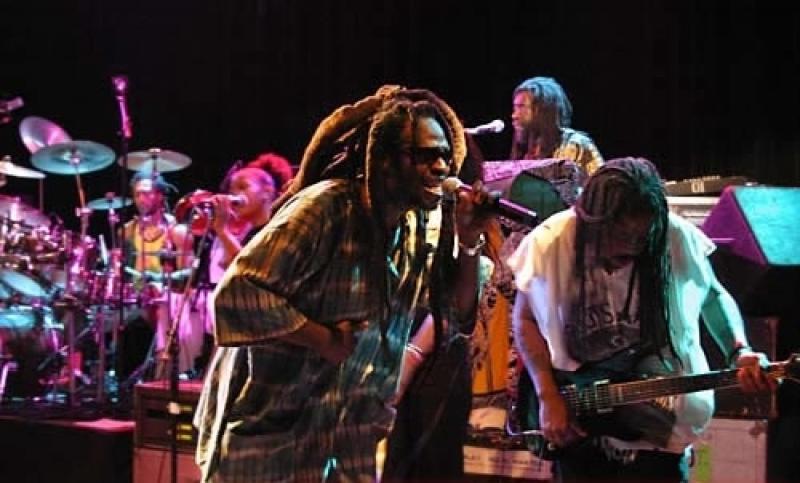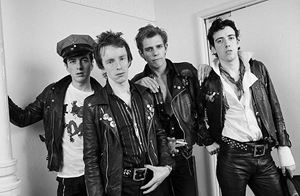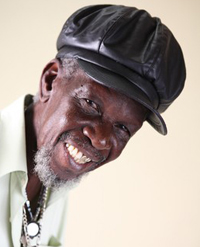Reggae Britannia/ Rocksteady: The Roots of Reggae, BBC Four | reviews, news & interviews
Reggae Britannia/ Rocksteady: The Roots of Reggae, BBC Four
Reggae Britannia/ Rocksteady: The Roots of Reggae, BBC Four
From Trenchtown to Camden Town with the Beeb's Reggae Britannia season

BBC Four's Britannia series keeps it simple - it tells the story in a straight line, illustrates it with as much archive material as the budget will allow, and interviews as many key protagonists as it can find. If the subject is strong enough, you'll get a good film out of it.
And so it was with the reggae edition (part of the Reggae Britannia season), which took a brisk 90-minute march from reggae's arrival in Britain from Jamaica in the Sixties to the point where it disappeared into Soul II Soul's dub/soul/R&B mixture. They'd rounded up pretty well everybody who ever had a stake in Brit-reggae and its various tributaries, from Don Letts and Jerry Dammers to members of Aswad, Steel Pulse and UB40.
Paul Simonon of the reggae-infatuated Clash (pictured below) recalled how himself and Joe Strummer had tried to set fire to a car during riots at the Notting Hill Carnival, and explained that The Clash's version of Junior Murvin's "Police and Thieves" had never set out to be reggae, but a punk band's idiosyncratic interpretation of it. Stewart Copeland of The Police, the band who cleaned up globally by turning reggae into white mainstream pop, was delightfully unapologetic. "We completely bastardised reggae," he beamed. "We plundered it without remorse."
 Reggae might never have happened in Britain without the entrepreneurial zeal of Island Records's Chris Blackwell, who these days resembles a veteran diplomat reciting extracts from his memoirs. His influence was immense, though the film avoided discussion of the colonialist overtones of a wealthy white Jamaican cashing in on black music.
Reggae might never have happened in Britain without the entrepreneurial zeal of Island Records's Chris Blackwell, who these days resembles a veteran diplomat reciting extracts from his memoirs. His influence was immense, though the film avoided discussion of the colonialist overtones of a wealthy white Jamaican cashing in on black music.
Reggae's most remarkable trait has been its adaptability, enabling it to form fruitful partnerships with punk, soul and pop, become a thunderous medium for black political consciousness in the hands of Linton Kwesi Johnson or Steel Pulse, and fly the flag for multiracial Britain via UB40 or The Specials. The film fizzled out rather weakly as reggae's identity grew diffuse, but I suppose you could say form mirrored function.
Rocksteady: The Roots of Reggae was a nostalgic trip back to mid-Sixties Jamaica, and the arrival of the "rocksteady" style which formed a bridge between ska and reggae. Hopeton Lewis, whose track "Take it Easy" urged "take it down, no need to hurry", explained that he started singing rocksteady because ska went too fast and he couldn't keep up.
The differences between rocksteady and reggae aren't instantly obvious - Bob Marley arrived at the tail end of the former and struck it rich with the latter - and it seemed that many songs tagged as reggae are probably rocksteady. When Blondie covered "The Tide is High", for instance, everyone thought they were playing reggae, but here was Marcia Griffiths singing it amidst a grand reunion of Jamaica's veteran rocksteady artists for a one-off concert in Kingston.
 The film (an expensively shot Swiss-Canadian co-production) used the gathering of the artists, many of whom hadn't seen each other for 40 years, as a pretext for a folk history of Jamaica, with the endearingly grizzled Wilburn "Stranger" Cole acting as narrator (pictured left). Many of the performers were fragile in health, but the years visibly fell away as they gathered to sing their old hits, many of which packed a searing emotional wallop. Judy Mowatt's "Silent River Runs Deep" was a beautiful soul-gospel mix, while "Equal Rights" was sung with bubbling energy by Leroy Sibbles and three old mates on the Kingston seafront.
The film (an expensively shot Swiss-Canadian co-production) used the gathering of the artists, many of whom hadn't seen each other for 40 years, as a pretext for a folk history of Jamaica, with the endearingly grizzled Wilburn "Stranger" Cole acting as narrator (pictured left). Many of the performers were fragile in health, but the years visibly fell away as they gathered to sing their old hits, many of which packed a searing emotional wallop. Judy Mowatt's "Silent River Runs Deep" was a beautiful soul-gospel mix, while "Equal Rights" was sung with bubbling energy by Leroy Sibbles and three old mates on the Kingston seafront.
In between, there were stories about how vibrant and optimistic Jamaica had seemed in the Sixties, after becoming independent from Britain in 1962 and before drugs and gang warfare took hold. Old news footage of the bustling Jamaica railway, which used to bring villagers to the city to find work, contrasted dismally with scenes of the now-derelict railway station. A lack of jobs had prompted waves of emigration, mainly to the USA. It was enough to bring a tremble to the lower lip.
- Find Rocksteady: The Roots of Reggae on Amazon
- Watch Reggae Britannia on BBC iPlayer
Explore topics
Share this article
The future of Arts Journalism
You can stop theartsdesk.com closing!
We urgently need financing to survive. Our fundraising drive has thus far raised £33,000 but we need to reach £100,000 or we will be forced to close. Please contribute here: https://gofund.me/c3f6033d
And if you can forward this information to anyone who might assist, we’d be grateful.

Subscribe to theartsdesk.com
Thank you for continuing to read our work on theartsdesk.com. For unlimited access to every article in its entirety, including our archive of more than 15,000 pieces, we're asking for £5 per month or £40 per year. We feel it's a very good deal, and hope you do too.
To take a subscription now simply click here.
And if you're looking for that extra gift for a friend or family member, why not treat them to a theartsdesk.com gift subscription?
more TV
 Flintoff, Disney+ review - tumultuous life and times of the great all-rounder
John Dower's documentary is gritty, gruelling and uplifting
Flintoff, Disney+ review - tumultuous life and times of the great all-rounder
John Dower's documentary is gritty, gruelling and uplifting
 Your Friends & Neighbors, Apple TV+ review - in every dream home a heartache
Jon Hamm finds his best role since 'Mad Men'
Your Friends & Neighbors, Apple TV+ review - in every dream home a heartache
Jon Hamm finds his best role since 'Mad Men'
 MobLand, Paramount+ review - more guns, goons and gangsters from Guy Ritchie
High-powered cast impersonates the larcenous Harrigan dynasty
MobLand, Paramount+ review - more guns, goons and gangsters from Guy Ritchie
High-powered cast impersonates the larcenous Harrigan dynasty
 This City is Ours, BBC One review - civil war rocks family cocaine racket
Terrific cast powers Stephen Butchard's Liverpool drug-ring saga
This City is Ours, BBC One review - civil war rocks family cocaine racket
Terrific cast powers Stephen Butchard's Liverpool drug-ring saga
 The Potato Lab, Netflix review - a K-drama with heart and wit
Love among Korean potato-researchers is surprisingly funny and ideal for Janeites
The Potato Lab, Netflix review - a K-drama with heart and wit
Love among Korean potato-researchers is surprisingly funny and ideal for Janeites
 Adolescence, Netflix review - Stephen Graham battles the phantom menace of the internet
How antisocial networks lead to real-life tragedy
Adolescence, Netflix review - Stephen Graham battles the phantom menace of the internet
How antisocial networks lead to real-life tragedy
 Drive to Survive, Season 7, Netflix review - speed, scandal and skulduggery in the pitlane
The F1 documentary series is back on the pace
Drive to Survive, Season 7, Netflix review - speed, scandal and skulduggery in the pitlane
The F1 documentary series is back on the pace
 A Cruel Love: The Ruth Ellis Story, ITV1 review - powerful dramatisation of the 1955 case that shocked the public
Lucy Boynton excels as the last woman to be executed in Britain
A Cruel Love: The Ruth Ellis Story, ITV1 review - powerful dramatisation of the 1955 case that shocked the public
Lucy Boynton excels as the last woman to be executed in Britain
 Towards Zero, BBC One review - more entertaining parlour game than crime thriller
The latest Agatha Christie adaptation is well cast and lavishly done but a tad too sedate
Towards Zero, BBC One review - more entertaining parlour game than crime thriller
The latest Agatha Christie adaptation is well cast and lavishly done but a tad too sedate
 Bergerac, U&Drama review - the Jersey 'tec is born again after 34 years
Damien Molony boldly follows in the hallowed footsteps of John Nettles
Bergerac, U&Drama review - the Jersey 'tec is born again after 34 years
Damien Molony boldly follows in the hallowed footsteps of John Nettles
 A Thousand Blows, Disney+ review - Peaky Blinders comes to Ripper Street?
The prolific Steven Knight takes us back to a squalid Victorian London
A Thousand Blows, Disney+ review - Peaky Blinders comes to Ripper Street?
The prolific Steven Knight takes us back to a squalid Victorian London
 Zero Day, Netflix review - can ex-President Robert De Niro save the Land of the Free?
Panic and paranoia run amok as cyber-hackers wreak havoc
Zero Day, Netflix review - can ex-President Robert De Niro save the Land of the Free?
Panic and paranoia run amok as cyber-hackers wreak havoc

Add comment